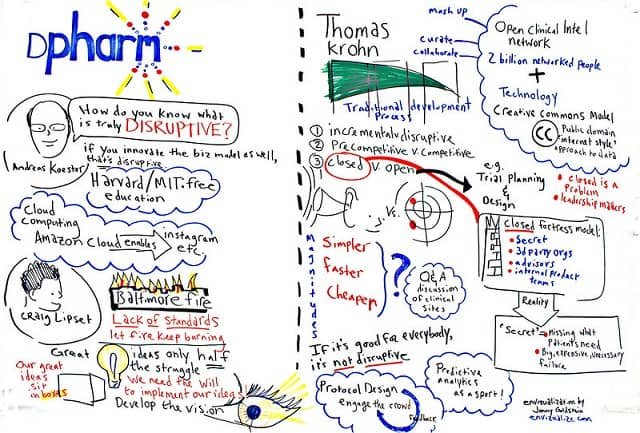In a constantly changing world, the concept of disruptive innovation has emerged as a crucial factor in understanding how companies, technologies, and business models reshape entire industries. This term, popularized by academic Clayton Christensen, describes how seemingly simple innovations can transform markets by offering more accessible and affordable alternatives to existing solutions.
Examples like Netflix, Amazon, Airbnb, among others, serve as inspiration for entrepreneurs to develop innovations. However, how can we learn to innovate? Innovation has become a necessity for companies; in this sense, those that fail to adopt innovation tools risk disappearing from the market.
In this article, we aim to discuss disruptive innovation. We will present some of the most accepted definitions, types of disruptive innovation, characteristics, and examples of companies that have successfully applied this concept.
In this regard, researchers such as Roblek et al. (2021) predict that within a 10-year period, only small and medium-sized enterprises that use or develop disruptive innovations will survive in the market.
What is Disruptive Innovation?
In 1995, Clayton M. Christensen coined the term disruptive innovation, explaining that “when we think of disruptive innovation, we refer to technologies or models that bring about significant changes.” In this sense, “disruption” describes a process through which a smaller company with fewer resources can successfully challenge established businesses (Christensen et al., 2015).
Rahman et al. (2017) define disruptive innovation as innovation that creates a new market and value chain, or enters an underserved market segment, eventually displacing market firms, products, and alliances.
On the other hand, Lile et al., (2024) propose a new approach to understanding disruption that goes beyond the traditional dichotomy between incumbents and disruptors. This perspective focuses on the dynamic interaction between challengers and incumbents, considering disruption as a multifaceted and interactive process.
In summary, the definition of disruptive innovation refers to a process in which a product or service begins on the fringes of an established market, often overlooked by leading companies, only to eventually redefine and dominate it. Disruptive innovations often emerge as more affordable and less sophisticated alternatives to dominant products, addressing previously unmet needs.
Key Characteristics
- Accessibility and Affordability: They are often cheaper and easier to use.
- Initial Focus on the Low-End Market: Disruptive innovations target consumers who cannot afford existing products or find them overly complex.
- Gradual Progress: As their quality and functionality improve, these innovations start to attract mainstream market customers.
Types of Disruptive Innovation
According to Christensen et al. (2015), disruptive innovations fall into two categories: low-end disruption and new-market disruption.
Low-End Disruption
Low-end disruption occurs when a company uses a low-cost business model to enter an existing market and capture an underserved segment of it.
Traditional companies’ offerings often exceed the performance requirements of the low-end segment, opening the door for a disruptor focused on providing a product that is “good enough” for that segment.
An example of low-end disruption is the rise of retail medical clinics in the healthcare space (Cote, 2020).
New-Market Disruption
New-market disruption occurs when a company creates a new segment within an existing market by offering a low-cost version of a product.
Disruptors establish a market where none previously existed. In other words, they turn non-consumers into consumers.
The key difference between these two types lies in their initial focus: low-end disruption targets less demanding customers in an existing market, whereas new-market disruption creates a new market for customers who previously had no options. However, both share the characteristic that established companies often ignore them in their early stages, allowing disruptive companies to gain traction and eventually displace them.
Disruptive Innovation vs. Sustaining Innovation
While disruptive innovation involves creating a new solution for unmet demand, sustaining innovation focuses solely on improving existing concepts or products. Christensen et al. (2015) emphasized that initially, the theory observed that established companies outperformed new entrants in sustaining innovations but underperformed in disruptive innovations. Researchers later realized this was because established companies listened to their existing customers and concentrated on sustaining innovations, while new entrants targeted ignored or underserved customer segments.
Table 01 presents a comparison between disruptive innovation and sustaining innovation.
Table 01: Disruptive Innovation vs. Sustaining Innovation.
| Aspect | Sustaining Innovation | Disruptive Innovation |
|---|---|---|
| Main Focus | Improve existing products or services for current, profitable customers. | Create “good enough” products or services for ignored segments or new markets. |
| Initial Target Market | Existing customers who value performance and incremental improvements. | Underserved markets, new markets, or customer segments ignored by established companies. |
| Starting Point | Within the main market with incremental improvements or significant advancements. | At the market’s fringe, starting with products considered inferior by the main market. |
| Goal | Increase sales to current customers through quality, functionality, or performance improvements. | Transform the market with a new business model and progressively attract the main market. |
| Initial Perception | Highly valued by established customers. | Considered inferior by customers of established companies. |
| Strategy | Maintain and strengthen the position in the existing market. | Pursue a new business model to compete outside the main market. |
| Evolution | Constant improvement within the current market standards. | Gradual improvement that eventually challenges and replaces established companies in the main market. |
| Examples | Fifth blade on a razor, higher-resolution TVs, better mobile coverage. | Personal photocopiers, Netflix (from DVDs by mail to streaming), digital cameras versus analog cameras. |
| Threat to Established Companies | Low: strengthens the relationship with current customers. | High: initially ignored, but over time represents a significant threat. |
| Success Probability | High, as long as current customer needs are understood. | Variable: depends on technological improvement, strategy, and the established market’s reaction. |
In Conclusion:
- Sustaining Innovation: Focused on improving products and services for existing customers, maintaining the status quo.
- Disruptive Innovation: Revolutionizes markets, starting at the fringes, with the potential to redefine entire industries.
Characteristics of Disruptive Innovation
Disruptive innovation is not a process of improvement or incremental upgrades for the same target group; it involves using technologies to make products easily accessible and available to a larger market (Twin, 2021).
Christensen et al. (2015) and Richards (2021) highlight the following characteristics of disruptive innovations:
- Disruption Is a Process: The term “disruptive innovation” can be misleading when used to refer to a product or service at a single point in time rather than the evolution of that product or service over time. Disruptive innovation is, therefore, a process.
- Disruptors Create Business Models Very Different From Traditional Operators: Entrepreneurs must envision new business models. A practical example is taking a technological concept, typically reserved for enterprises, and making it accessible to consumers.
- Lower Margins: Disruptors accept lower margins and often focus on systematization and high volume to maintain profitability.
- Higher Risks: Disruptors frequently face higher risks. This is essential as the existence of customers has yet to be proven.
- Disruptors Are Evangelists for an Entirely New Category
- Some Disruptive Innovations Succeed, Others Do Not: Success is not inherent to the definition of disruption: not all disruptive paths lead to success. Many internet-based retailers followed disruptive paths in the late 1990s, but only a few thrived.
- The Mantra “Disrupt or Be Disrupted” Can Be Misleading: Established companies must respond to disruptions if they occur, but they should avoid overreacting by dismantling still-profitable businesses.
How to Prepare Your Company for Disruptive Innovation
Based on their research, Roblek et al (2021) provide the following recommendations for companies embarking on the path of disruptive innovation:
- Understand Disruptive Innovations and Their Market Impact: Companies should set ambitious goals for disruptive innovation development as these innovations significantly affect the market.
- Develop Employee Competencies: Employees should feel confident and prepared for new challenges. Crucial competencies include a desire for progress, a willingness to learn, adopting new work methods, and creativity/innovation orientation. Dzimba y Van der Poll (2024) found that higher education levels and industry experience correlate with better strategic postures for disruptive innovation.
- Implement the Concept of Open Innovation: Special attention should be given to collaboration with academia, an important tool for achieving disruptive innovations.
- Adopt a Dynamic Market Opportunity Identification Model: Companies should focus on identifying market opportunities dynamically and ensuring shorter time-to-market periods.
- Implement Enabling Technologies: Fully integrate digitalization at all levels of the company.
Stages of Disruptive Innovation
Antonio y Kanbach (2023) emphasize the importance of companies understanding the different phases of the disruptive process to make better strategic decisions. Similarly, O’Reilly y Binns (2019) describe three stages of disruptive innovation: idea generation, incubation, and scaling.
Idea Generation
Idea generation is the first step toward disruptive innovation. Over the past 20 years, companies have implemented various approaches to foster idea generation, making corporate boundaries more permeable. Preißner et al., (2024) found that 43% of sampled disruptive innovations were originally developed by users, another 43% by producers, and the remaining 13% from other sources. This suggests that both customers and companies can generate ideas for disruptive innovations.
The approaches used include open innovation, corporate venture capital (CVC), design thinking, and employee participation. To determine whether a product or service is disruptive relative to an incumbent offering, the Clayton Christensen Institute recommends answering these six questions, each indicating potential disruption:
- Is it targeted at non-consumers or those overserved by the incumbent’s existing offerings in the market?
- Is the offering inferior to the incumbent’s existing product based on historical performance measures?
- Is the innovation simpler to use, more convenient, or more affordable than the incumbent’s existing offering?
- Does the offering have a technological enabler that can elevate it and allow for improvement?
- Is the technology paired with a business model innovation that makes it sustainable?
- Are existing providers motivated to ignore the new innovation and initially not feel threatened by it?
Incubation: Validating the New Idea
Incubation, or validation, is a process to determine whether the idea passes a market test. Three methodologies address this challenge: Lean Startup, the Business Model Canvas, and Stanford’s Launch Platform.
Antonio and Kanbach (2023) highlight that contextual factors—including market aspects, regulation, culture, and society—play a crucial role in the disruption process. These factors influence where disruption occurs, its success, and how established companies react.
Scaling
Scaling or growing a successful new business is always challenging. It is less problematic for entrepreneurial companies where growth depends on attracting new capital and recruiting new talent.
For scaling success, a new venture needs to acquire customers and grow quickly enough to maximize market opportunities.
Examples of Companies Applying Disruptive Innovation
In recent decades, the most significant example of disruptive innovation has been the development of the internet, which revolutionized communications and the way information is transmitted.
Disruptive companies are those that revolutionize the market by intensively using disruptive technologies such as artificial intelligence, robotics, blockchain, and the Internet of Things. These companies typically build business models that are vastly different from those of established enterprises.

Examples of Disruptive Companies Leveraging Disruptive Technologies and Leading the World:
Amazon
Amazon is the classic example of disruptive innovation that transformed the book-selling industry. The company leveraged the internet to showcase its inventory without needing a physical store in every city, as traditional bookstores did. Customers could process purchases online and have books delivered directly to their homes.
Amazon’s popularity grew alongside its profits and market share.
Netflix
Netflix is another disruptive innovator. By utilizing the growing power of the internet, it offered consumers the ability to access entertainment online.
Netflix‘s success came from transforming the movie rental industry, where physical rentals often had to be returned the next day. The company focused on customer dissatisfaction with traditional services and created a new market segment.
Apple
Christensen et al. (2015) highlight Apple’s use of an innovative business model to drive disruption with the iPhone. They note that the iPhone, which debuted in 2007, was a sustaining innovation in the smartphone market, targeting the same coveted customers as traditional players.
However, the subsequent growth of the iPhone is better explained by its disruption: turning the phone into the primary gateway to the internet. This was achieved by introducing a new business model—connecting app developers with phone users.
Software as a Service (SaaS)
Richards (2021) reports that, in the past, most commercial software was expensive and required computers with substantial processing power and capacity to download and run programs.
As internet speed and reliability improved and computers became more affordable, the SaaS industry began to flourish.
Today, companies no longer need to pay thousands of dollars for enterprise software. Instead, the SaaS model allows micro and small businesses to pay a monthly fee for a cloud-based service.
Airbnb
Airbnb disrupted the accommodation business model by allowing individuals to open their homes to host guests for short periods, often at much lower prices than hotels.
Guttentag (2015) published a study exploring Airbnb’s rise, highlighting its use of disruptive innovation concepts and identifying it as a new business model.
Conclusion
Disruptive innovation has become a necessity for companies. In a constantly changing world and market, businesses that fail to innovate are destined to disappear. Understanding examples of companies that have successfully applied disruptive innovation can help you grasp the concept and explore how to use it in your organization.
Disruptive innovation is a powerful force capable of transforming industries and markets. Understanding its principles and mechanisms is crucial for companies, entrepreneurs, and innovators seeking to make a significant impact. Finally, it is important to note that the theory of disruption does not guarantee success but provides a framework for understanding how emerging companies can challenge established players.
References
Antonio, J. L., & Kanbach, D. K. (2023). Contextual factors of disruptive innovation: A systematic review and framework. Technological Forecasting and Social Change, 188, 122274. https://doi.org/10.1016/j.techfore.2022.122274
Christensen C., Michael E. Raynor, and Rory McDonald. 2015. What Is Disruptive Innovation? Harvard Business Review.
Cote C. 2020. What is disruptive innovation? Harvard Business School.
Dzimba, E., & Van der Poll, J. A. (2024). Disruptive innovation capability in resource-constrained environments: The role of strategic posture and human capital. Sustainable Futures, 8, 100326. https://doi.org/10.1016/j.sftr.2024.100326
Guttentag D. (2015) Airbnb: disruptive innovation and the rise of an informal tourism accommodation sector, Current Issues in Tourism, 18:12, 1192-1217, DOI: 10.1080/13683500.2013.827159
Lile, S., Ansari, S. (Shaz), & Urmetzer, F. (2024). Rethinking disruptive innovation: unravelling theoretical controversies and charting new research frontiers. Innovation, 1–23. https://doi.org/10.1080/14479338.2024.2313197
O’Reilly, Charles, and Andrew J. M. Binns. “The Three Stages of Disruptive Innovation: Idea Generation, Incubation, and Scaling.” California Management Review 61, no. 3 (May 2019): 49–71. https://doi.org/10.1177/0008125619841878.
Preißner, S., Raasch, C., & Schweisfurth, T. (2024). When necessity is the mother of disruption: Users versus producers as sources of disruptive innovation. Journal of Product Innovation Management, 41(1), 62-85. https://doi.org/10.1111/jpim.12709
Richards R. 2021. Disruptive Innovation: The Inevitable Change Every Market Must Face. MC Masschallenge.
Twin A. 2021. Disruptive Innovation. Investopedia.
Rahman, Airini; et al. (2017). “Emerging Technologies with Disruptive Effects: A Review“. PERINTIS eJournal. 7 (2).
Roblek Vasja, Maja Meško, Franci Pušavec and Borut Likar. 2021. The Role and Meaning of the Digital Transformation As a Disruptive Innovation on Small and Medium Manufacturing Enterprises. Front. Psychol., 09 June 2021 | https://doi.org/10.3389/fpsyg.2021.592528
Editor and founder of “Innovar o Morir” (‘Innovate or Die’). Milthon holds a Master’s degree in Science and Innovation Management from the Polytechnic University of Valencia, with postgraduate diplomas in Business Innovation (UPV) and Market-Oriented Innovation Management (UPCH-Universitat Leipzig). He has practical experience in innovation management, having led the Fisheries Innovation Unit of the National Program for Innovation in Fisheries and Aquaculture (PNIPA) and worked as a consultant on open innovation diagnostics and technology watch. He firmly believes in the power of innovation and creativity as drivers of change and development.





